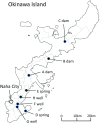Distribution of Aeromonas species in environmental water used in daily life in Okinawa Prefecture, Japan
- PMID: 27075357
- PMCID: PMC5305980
- DOI: 10.1007/s12199-016-0528-0
Distribution of Aeromonas species in environmental water used in daily life in Okinawa Prefecture, Japan
Abstract
Objectives: The genus Aeromonas is known to causes diseases such as food poisoning, sepsis, and wound infection. However, the mode of Aeromonas transmission from environment to humans is not clearly understood. To evaluate the health risks of Aeromonas spp. in environmental freshwater, the number, proportion and putative virulence factors of Aeromonas species were investigated in Okinawa Prefecture, Japan.
Methods: Environmental freshwater samples were collected from three dams, two springs and three private wells. Aeromonas strains were identified by the biochemical method and the viable count was calculated. The production of extracellular enzymes and the virulence genes were investigated for possessing putative virulence factors using representative isolates.
Results: At least seven species of already-known Aeromonas isolates as well as unidentified Aeromonas spp. with/without arginin dehydrolase (ADH) exist in water at these sites. Aeromonas spp. was found to exist at over 1000 CFU/100 ml in one spring and two wells. A. veronii biovar sobria and A. jandaei were the predominant species in dams, and A. hydrophila and/or A. eucrenophila were predominant in wells. Almost all the sampled Aeromonas species produced protease, gelatinase, lipase, esterase and DNase, but A. caviae, A. caviae-like bacteria, and A. eucrenophila had low hemolytic activity. Most sampled A. hydrophila strains possessed both aerolysin gene (aer) and hemolysin gene (hlyA), but A. caviae and A. eucrenophila strains did not possess either gene.
Conclusions: Since these results indicated that several Aeromonas species having potential pathogenicity exist in environmental water in Okinawa, surveys are recommended as a public health measure.
Keywords: Aeromonas species; Distribution; Environmental water; Proportion; Putative virulence factors.
Conflict of interest statement
The authors have no conflicts of interest.
Figures


Similar articles
-
Virulence markers in Aeromonas hydrophila and Aeromonas veronii biovar sobria isolates from freshwater fish and from a diarrhoea case.J Appl Microbiol. 2002;93(3):414-9. doi: 10.1046/j.1365-2672.2002.01705.x. J Appl Microbiol. 2002. PMID: 12174039
-
Comparison of species, virulence genes and clones of Aeromonas isolates from clinical specimens and well water in Okinawa Prefecture, Japan.J Appl Microbiol. 2021 Sep;131(3):1515-1530. doi: 10.1111/jam.15038. Epub 2021 Mar 2. J Appl Microbiol. 2021. PMID: 33570830
-
Sanitary evaluation of domestic water supply facilities with storage tanks and detection of Aeromonas, enteric and related bacteria in domestic water facilities in Okinawa Prefecture of Japan.Water Res. 2017 Aug 1;119:171-177. doi: 10.1016/j.watres.2017.04.002. Epub 2017 Apr 5. Water Res. 2017. PMID: 28458058
-
Properties of aeromonads and their occurrence and hygienic significance in drinking water.Zentralbl Bakteriol Mikrobiol Hyg B Umwelthyg Krankenhaushyg Arbeitshyg Prav Med. 1988 Nov;187(1):1-17. Zentralbl Bakteriol Mikrobiol Hyg B Umwelthyg Krankenhaushyg Arbeitshyg Prav Med. 1988. PMID: 3146172 Review.
-
Aeromonas update: new species and global distribution.Experientia. 1991 May 15;47(5):402-3. Experientia. 1991. PMID: 2044682 Review.
Cited by
-
Molecular Epidemiology, Virulence Traits and Antimicrobial Resistance Signatures of Aeromonas spp. in the Critically Endangered Iberochondrostoma lusitanicum Follow Geographical and Seasonal Patterns.Antibiotics (Basel). 2021 Jun 22;10(7):759. doi: 10.3390/antibiotics10070759. Antibiotics (Basel). 2021. PMID: 34206643 Free PMC article.
-
Metagenomic analysis and proteins prediction of emerging pathogens in artisanal cheese.Mol Divers. 2025 Feb 6. doi: 10.1007/s11030-025-11116-7. Online ahead of print. Mol Divers. 2025. PMID: 39915364
-
The first detection of two Aeromonas strains in mice of the genus Apodemus.Sci Rep. 2023 Mar 15;13(1):4315. doi: 10.1038/s41598-023-31306-3. Sci Rep. 2023. PMID: 36922567 Free PMC article.
-
Water as a Source of Indoor Air Contamination with Potentially Pathogenic Aeromonas hydrophila in Aquaculture.Int J Environ Res Public Health. 2022 Feb 18;19(4):2379. doi: 10.3390/ijerph19042379. Int J Environ Res Public Health. 2022. PMID: 35206565 Free PMC article.
-
One Health and Global Health View of Antimicrobial Susceptibility through the "Eye" of Aeromonas: Systematic Review and Meta-Analysis.Int J Antimicrob Agents. 2023 Aug;62(2):106848. doi: 10.1016/j.ijantimicag.2023.106848. Epub 2023 May 16. Int J Antimicrob Agents. 2023. PMID: 37201798 Free PMC article.
References
-
- http://www.bacterio.cict.fr/. Accessed 25 Jan 2016.
MeSH terms
Substances
LinkOut - more resources
Full Text Sources
Other Literature Sources
Medical
Miscellaneous
